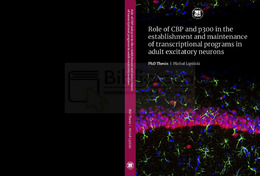Please use this identifier to cite or link to this item:
https://hdl.handle.net/11000/30259Full metadata record
| DC Field | Value | Language |
|---|---|---|
| dc.contributor.advisor | Barco, Ángel | - |
| dc.contributor.advisor | López-Atalaya, José Pascual | - |
| dc.contributor.author | Lipinski, Michal | - |
| dc.contributor.other | Instituto de Neurociencias | es_ES |
| dc.date.accessioned | 2023-11-23T12:41:48Z | - |
| dc.date.available | 2023-11-23T12:41:48Z | - |
| dc.date.created | 2019-12-02 | - |
| dc.identifier.ismn | 1670 | - |
| dc.identifier.uri | https://hdl.handle.net/11000/30259 | - |
| dc.description.abstract | The paralog lysine acetyltransferases (KAT) CREB binding protein (CBP) and E1A binding protein (p300) are both essential for the normal development of the nervous system, but their specific function in post-mitotic neurons remain unclear. To investigate these functions, we produced inducible forebrain-specific knockout mice for either one or both proteins. When both KATs were knocked out simultaneously in the adult brain, but not after individual ablation, mice showed a rapid deterioration, severe neurological phenotypes and premature death. These phenotypes were associated with the reduction of once-acquired dendritic complexity and electrical activity in excitatory neurons, which correlates with the transcriptional shutdown of neuronal genes and a dramatic loss of H3K27 acetylation and occupancy by pro-neural transcription factors at neuronal enhancers. Targeted lysine acetylation using the CRISPR/dCas9 system restituted neuronal-specific gene expression. These experiments demonstrate that KAT3 proteins are necessary for maintaining neuronal identity and function in the adult brain by preserving correct chromatin acetylation levels. Further insight into the phenotype of a single-KAT3 induced forebrain knockouts showed that a homozygous loss of a CBP caused a highly specific phenotype in cognition, transcription and histone acetylation. Meanwhile, the modest changes in histone acetylation caused homozygous loss of p300 did not correlate with any changes in behavior or gene expression. Interestingly, the difference between CBP and p300 was highlighted when mice were exposed to a neuroadaptive paradigm like environmental enrichment or pro-epileptic drug sensitization. Whereas the p300 knockouts again did not show any difference from the control littermates, the CBP knockout mice were unable to adapt to the environmental change. This effect was paralleled by a failure in induction a specific gene expression programs induced in control mice as a result of the challenge. Therefore, CBP and p300 jointly maintain neuro-specific transcriptional programs in adult excitatory neurons, and CBP seems to be vital for shifting these programs in response to experiences or environmental changes. | es_ES |
| dc.format | application/pdf | es_ES |
| dc.format.extent | 279 | es_ES |
| dc.language.iso | eng | es_ES |
| dc.publisher | Universidad Miguel Hernández | es_ES |
| dc.rights | info:eu-repo/semantics/openAccess | es_ES |
| dc.rights | Attribution-NonCommercial-NoDerivatives 4.0 Internacional | * |
| dc.rights.uri | http://creativecommons.org/licenses/by-nc-nd/4.0/ | * |
| dc.subject | Neurociencias | es_ES |
| dc.subject.other | CDU::6 - Ciencias aplicadas::61 - Medicina::616 - Patología. Medicina clínica. Oncología::616.8 - Neurología. Neuropatología. Sistema nervioso | es_ES |
| dc.title | Role of CBP and p300 in the establishment and maintenance of transcriptional programs in adult excitatory neurons | es_ES |
| dc.type | info:eu-repo/semantics/doctoralThesis | es_ES |

View/Open:
TD. Lipinski, Michal_compressed_compressed.pdf
11,22 MB
Adobe PDF
Share:
.png)
